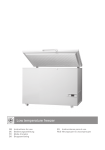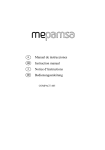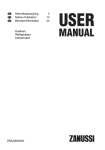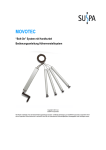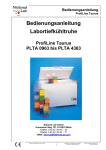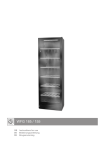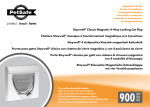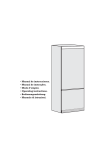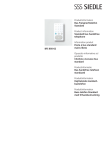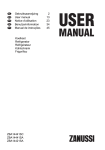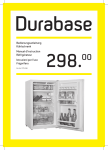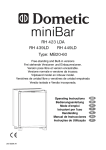Download labortiefkuehltruhe-l86tk200-bedienungsanleitung-kbs
Transcript
Bedienungsanleitung Labortiefkühltruhe L86TK200 Stand 08/2014 DE Die Bedienungsanleitung muss den Mitarbeitern jederzeit zugänglich sein. Dieses Gerät entspricht den Regelungen zur CE Kennzeichnung sowie den einschlägigen Richtlinien und Normen. Niederspannungsrichtlinie 73/23/EWG. EMV Richtlinie 89/336/EWG. Alte Geräte Warnung Vor dem Gebrauch Alte Kühl- und Gefriergeräte sind häufig mit komplizierten Schnappschlössern versehen, die von innen nicht geöffnet werden können. Falls bei Ihnen ein solches Gerät steht, oder wenn Sie ein solches Gerät ausrangieren, machen Sie bitte zuerst das Schloss unbrauchbar. So verhindern Sie, dass spielende Kinder eingesperrt werden und in Lebensgefahr kommen können. Da das Gerät ein brennbares Kältemittel enthält, dürfen die Kältemittelleitungen niemals beschädigt sein! Vor dem Gebrauch Ihres neuen Geräts sollten Sie diese Bedienungsanleitung gründlich lesen. Sie enthält wichtige Informationen zu Sicherheit, Installation, Betrieb und Wartung. Bewahren Sie die Bedienungsanleitung auf. Sie könnten Sie zu einem späteren Zeitpunkt evtl. benötigen. Kontrollieren Sie das Gerät sofort bei Lieferung auf eventuelle Beschädigungen. Transportschäden sind dem Händler zu melden, bevor das Gerät in Gebrauch genommen wird. Verpackung entfernen. Reinigen Sie das Gerät innen mit warmem Wasser, dem Sie etwas unparfümiertes Spülmittel zugeben. Mit sauberem Wasser nachwischen und gründlich trocknen (siehe “Reinigung”). Verwenden Sie ein weiches Tuch. Wurde das Gefriergerät bei Temperaturen unter +5 °C gelagert, muss vor dem ersten Einschalten mindestens eine Stunde zur Akklimatisierung vergehen. - Das Verstopfen von Belüftungsöffnungen im Gerätegehäuse oder der Einbauumgebung ist zu vermeiden. - Keine mechanischen Geräte oder andere Mittel zur Beschleunigung des Abtauvorgangs einsetzen, wenn diese nicht ausdrücklich vom Hersteller empfohlen sind. - Den Kältemittelkreislauf nicht beschädigen. - In den Lebensmittellagerabteilen keine elektrischen Geräte verwenden, sofern diese nicht vom Hersteller empfohlen sind. Dieses Gerät ist nicht für die Bedienung durch Kinder oder gebrechliche Personen bestimmt, sofern sie nicht von verantwortlichen Personen beaufsichtigt werden, um sicherzustellen, dass sie das Gerät sicher bedienen können. Kleine Kinder dürfen nicht mit dem Gerät spielen. Die Schlüssel stets separat und außerhalb der Reichweite von Kindern aufbewahren. Niemals Behälter mit Flüssigkeiten, insbesondere kohlensäurehaltige Getränke, in dem Gefriergerät aufbewahren. Die Flüssigkeit kann beim Gefrieren eine Explosion verursachen. Die kühlenden Oberflächen nie mit bloßer Haut berühren. Stets Handschuhe tragen, um Verbrennungen zu vermeiden. Inhalt Lernen Sie Ihr Gefriergerät kennen....3 Inbetriebnahme und Installation..........4 Elektrischer Anschluss.......................5 Bedienung und Funktion.....................6 Parametereinstellungen......................7 Bedienungsbefehle.............................. 8 Abtauen.............................................. 9 Reinigung und Wartung................... 10 Fehlersuche...................................... 11 Ersatzteile..........................................12 Entsorgung.................................... 13 Elektroschaltplan............................... 14 2 DE Lernen Sie Ihr Gefriergerät kennen Handgriff Dichtleiste Typenschild Trennwand/Tauwasserschale Korb Ventilationsrost Elektronisches Bedienungsfeld Tauwasserabfluss Rollen Abb. 1 3 DE Inbetriebnahme und Installation Aufstellort 800 mm Aus Sicherheits- und betriebstechnischen Gründen darf das Gerät nicht im Freien aufgestellt werden. Stellen Sie das Gerät auf einen ebenen, waagerechten und festen Untergrund in einem trockenen, gut belüfteten Raum (max. 75 % relative Luftfeuchtigkeit). Stellen Sie das Gerät nicht in unmittelbarer Nähe von Wärmequellen wie Herden oder Heizkörpern auf, und vermeiden Sie direkte Sonneneinstrahlung oder Wärme von anderen Wärmequellen. Die Norm EN 378 legt fest, dass der Aufstellraum, in dem Ihr Gerät installiert wird einen Rauminhalt von 1 m³ pro 8 g Kohlenwasserstoffkältemittel im Gerät haben muss, um die Bildung eines brennbaren Gasgemischs in dem Aufstellraum zu verhindern, falls ein Leck im Kältekreislauf auftritt. Die Menge des im Gerät befindlichen Kältemittels geht aus dem Typenschild hervor. 10 0 SN +10 ºC bis +32 ºC N +16 ºC bis +32 ºC ST +18 ºC bis +38 ºC T +18 ºC bis +43 ºC m 100 m Abb. 2 Zwischen dem Geräteboden und der Unterlage muss der Abstand mindestens 35 mm betragen. Das Gerät ist zum Betrieb in dem auf dem Typenschild angegebenen Temperaturbereich ausgelegt. Die Angaben zur Klimaklasse und andere technische Daten finden Sie auf dem Typenschild an der Geräterückseite. Zulässige Raumtemperatur m 20 mm Raumtemperatur Klimaklasse m WICHTIG! Der Belüftungsrost muss frei zugänglich sein (Abb. 3). Belüftung Abb. 3 Das Gerät muss ausreichend belüftet sein, und die Luftzirkulation über und unter ihm sowie seitlich von ihm darf nicht behindert sein. Abb. 2 zeigt, wie die erforderliche Luftzirkulation um das Gefriergerät herum gewährleistet wird. 4 DE Elektrischer Anschluss Das Gerät ist zum Anschluss an das Wechselstromnetz bestimmt. Die Werte für Spannung (V) und Frequenz (Hz) sind auf dem Typenschild an der Geräterückseite angegeben. Das Gerät ist allein an eine eigene Steckdose anzuschließen. Das Netzkabel ist direkt mit der Steckdose zu verbinden. Keine Verlängerungskabel verwenden! Bei Beschädigung des Netzkabels ist es durch ein gleichwertiges Teil zu ersetzen, das vom Hersteller oder dessen Kundendienst geliefert wird. 5 DE Bedienung und Funktion Das Gerät ist mit einer elektronischen Steuerung ausgerüstet (Abb. 4) Abb. 4 Für die Bedienung der elektronischen Steuerung verweisen wir auf die separate Bedienungsanleitung im Gerät. 6 DE Abtauen Das Gefriergut und die Luftfeuchtigkeit verursachen mit der Zeit Reif und Eis im Innern der Gefriertruhe. Eine dünne Reifoder Eisschicht setzt die Leistung des Geräts nicht herab, aber mit zunehmender Stärke des Belags erhöht sich der Energieverbrauch. Etwas loser Reif lässt sich mit einem Kunststoffschaber entfernen. Nicht vergessen, den Tauwasserablauf wieder mit dem Stopfen zu verschließen. Niemals elektrische Geräte oder scharfe Werkzeuge zum Entfernen von Reif/Eis verwenden, da sie das Truheninnere beschädigen können. Abb. 8 Erreicht die Reif- oder Eisschicht 4-5 mm Stärke, muss das Gerät abgetaut werden. Wir empfehlen, das Gefriergerät abzutauen, wenn nur wenige Waren darin gelagert sind. Gehen Sie folgendermaßen vor: 1. Deckel offen lassen. 2. Trennwand unter Tauwasserablauf legen. 3. Eine Schüssel mit warmem (nicht kochendem) Wasser in das Gerät stellen und den Deckel schließen. Ca. 30 Minuten warten und die Reifschicht dann mit dem Kunststoffschaber entfernen. 4. Um während des Abtauvorgangs Wasser auf dem Fußboden zu vermeiden, ist die Tauwasserschale regelmäßig zu kontrollieren. Der Boden um den Tauwasserablauf herum sollte abgedeckt werden, um ihn gegen Eis und Wasserspritzer zu schützen. Nachdem das Eis getaut ist, das Gefriergerät mit einer schwachen Lösung aus Wasser und unparfümiertem Spülmittel reinigen. Mit einem trockenen Tuch nachwischen. 5. Versorgungsspannung anschließen. 6. Das Lagergut kann wieder ins Gerät gelegt werden, wenn die Temperatur korrekt ist. 7 DE Reinigung und Wartung Reinigung Austausch der Lampe Vor der Reinigung ist der Netzstecker zu ziehen und das lose Zubehör aus dem Gerät zu entfernen. 1. Netzstecker ziehen. 2. Lampenschirm abnehmen (Abb. 9). Den Schirm zusammendrücken, sodass er sich von den beiden Klipps löst. 3. Glühlampe(n) austauschen. 4. Lampenschirm wieder anbringen und Versorgungsspannung anschließen. Eine Mischung aus warmem Wasser und unparfümiertem Spülmittel (max. 85 ºC) ist dazu am besten zur Reinigung geeignet. Verwenden Sie keine Reinigungsmittel, die Kratzer verursachen können. Verwenden Sie ein weiches Tuch. Mit klarem Wasser nachwischen und gut abtrocknen. Es darf kein Wasser in die Bedienungselemente gelangen. max. 15 W Die Deckeldichtleiste muss regelmäßig gereinigt werden, um Verfärbungen zu vermeiden und lange Haltbarkeit zu gewährleisten. Klares Wasser verwenden. Nach der Reinigung der Dichtleiste prüfen, ob sie dicht schließt. Abb. 9 Sparen Sie Energie Wir empfehlen die Reinigung der Drahtund Röhrenkondensatoren an der Geräterückseite. - Deckel möglichst geschlossen halten. - regelmäßig prüfen, dass der Deckel dicht schließt - die Gefriertruhe in einem kühlen (max. 5 °C), gut belüfteten Raum aufstellen. - Gefriergerät abtauen, bevor die Eisschicht zu dick wird. Den Lüftungsrost frei von Staub und Schmutz halten. Zur Reinigung des Rosts einen Staubsauger verwenden. Bei längerer Außerbetriebnahme, den Netzstecker ziehen und die Gefriertruhe ausräumen und reinigen. Den Deckel nicht schließen, um Geruchsbildung zu vermeiden. 8 DE Fehlersuche Fehler Mögliche Ursache Abhilfe Keine Kontrolllampe leuchtet. Das Gerät ist ausgeschaltet. Stecker und Schalter prüfen. Stromausfall; Sicherung hat angesprochen; Netzstecker nicht richtig eingesteckt. Prüfen, ob der Strom angeschlossen ist. Die Sicherung muss intakt/eingeschaltet sein. Der Belüftungsrost ist blockiert. Für unbehinderte Luftzirkulation sorgen. Der Deckel der Gefriertruhe ist nicht ordnungsgemäß geschlossen. Deckel schließen und einige Stunden lang warten. Es wurde mehr neues Gefriergut in das Gerät gelegt, als gleichzeitig eingefroren werden kann. Einige Stunden warten. Starke Reif- und Eisschicht. Gefriergerät abtauen. Thermostat zu warm eingestellt. Thermostat auf niedrigere Temperatur einstellen. Thermostat zu kalt eingestellt. Thermostat auf höhere Temperatur einstellen. Deckel liegt auf Gefriergut auf. Gefriergut umlagern und prüfen, ob der Deckel nun dicht schließt. Der Raum ist sehr feucht. Häufig lüften oder Gerät in einem anderen, trockeneren Raum aufstellen. Die Temperatur im Gefrierraum ist zu hoch. Temperatur im Gefriergerät zu niedrig. Gefriergerät setzt schnell Reif an. Das Gefriergut gibt Feuchtigkeit ab. Gefriergut umpacken. Deckel lässt sich nicht öffnen. Unterdruck im Gefriergerät. 2-3 Minuten warten, bis der Unterdruck abgebaut ist, dann erneut versuchen. Vibrationen und ungewöhnliche Geräusche. Das Gerät steht nicht auf einer ebenen Unterlage. Gerät auf eine ebene, waagerechte und feste Unterlage stellen. Das Gerät steht nicht frei. Gerät von Möbeln oder anderen Geräten abrücken. Körbe oder Trennwand sind locker. Die beweglichen Teile prüfen und wieder einsetzen. 9 DE Ersatzteile Ersatzteile Bitte bei der Ersatzteilbestellung Typ- und Seriennummer sowie Produktionsnummer angeben (siehe Abb. 1, Seite 3 und Abb. 10). Diese Angaben finden Sie auf dem Typenschild an der Geräterückseite. Das Typenschild enthält verschiedene technische Angaben, u.a. auch Typ- und Seriennummer. Serial No.: XXXXXXXX Type: XXXX Prod. No.: XXXX Abb. 10 Denken Sie daran! Stets nur autorisierte Handwerker beauftragen, wenn ein Teil repariert oder ausgewechselt werden muss! Wichtig Bitte beachten, dass Eingriffe in dem Aufbau des Gerätes oder Änderungen der Komponentenbestückung zur Folge haben, die Garantie und Produktenhaftung entfallen, und die Anwendung des Gerätes ist nicht zulässig. Die auf dem Typenschild angeführte Genehmigung ist auch ungültig. 10 DE Umweltschutz Verpackung Entsorgung Das Verpackungsmaterial ist vollständig recyclebar und mit Recyclingsymbolen gekennzeichnet. Beachten Sie bitte die bei Ihnen gültigen Entsorgungsvorschriften. Beachten Sie in jedem Fall die jeweils geltenden Umweltschutzbestimmungen. Bei Ihrem zuständigen Stadtreinigungsamt können Sie erfahren, wie Abtransport und Wiederverwertung dieser Geräte in Ihrer Gemeinde gehandhabt werden. Gerät Das Gerät besteht aus recyclingfähigem Material. Das Gerät enthält brennbare Gase, und die Entsorgung hat gemäß den jeweils geltenden Umweltbestimmungen zu erfolgen. Bitte machen Sie das Gerät durch Abschneiden des Netzkabels unbrauchbar, und liefern Sie es bei einer autorisierten Kühlgerätesammelstelle ab. Dieses Produkt ist gemäß der EURichtlinie 2002/96/EG über ausrangierte elektrische und elektronische Ausrüstung (WEEE) gekennzeichnet. Durch eine ordnungsgemäße Entsorgung dieses Produkts helfen Sie mit, potentiell negative Folgen für die Umwelt und die Gesundheit der Bevölkerung zu vermeiden, die durch eine unsachgemäße Entsorgung verursacht werden könnten. Das Symbol am Produkt oder auf schriftlichem Begleitmaterial bedeutet, dass das Produkt nicht zusammen mit Haushaltsabfall entsorgt werden darf. Es muss vielmehr bei einer Sammelstelle für elektrische und elektronische Ausrüstung abgeliefert werden. Die Entsorgung hat gemäß den jeweils vor Ort geltenden Umweltbestimmungen für die Abfallentsorgung zu erfolgen. Weitere Informationen zu Behandlung, Recycling und Wiederverwertung dieses Produkts bekommen Sie bei Ihren zuständigen Behörden, der Müllabfuhr oder dem Händler, bei dem Sie das Gerät erworben haben. 11 GB Old appliances The operating instructions should always be available to and accessible for the personnel! The appliance concerned complies with CE marking regulation, Directives and standards. Low Voltage Directive 73/23/EEC. Electromagnetic Compatibility Directive 89/336/EEC. Old refrigerators and freezers are often fitted with complicated latches that can only be opened from the outside. If you have one of these old units stored away somewhere, or if you scrap one, remember to destroy the latch first in order to prevent children from being exposed to great danger by getting locked inside the unit. Warning Before use As the appliance contain a refrigerant which are flammable it is essential to ensure that the refrigerant pipes are not damaged. Before operating your new appliance, please read the following instructions carefully as they contain important information on safety, installation, operation and maintenance. Keep the instructions for future reference. On receipt, check to ensure that the appliance has not been damaged. Transport damage should be reported to the local distributor before the appliance is put to use. Remove the packaging. Clean the inside of the appliance using warm water with a mild, perfume-free detergent. Rinse with clean water and dry thoroughly (see cleaning instructions). Use a soft cloth. If the appliance has been stored in cold surroundings (colder than +5°C), it must be allowed to stabilise for at least an hour before being switched on. - Keep clear of obstruction all ventilation openings in the appliance enclosure or in the structure for building-in. - Do not use mechanical devices or other means to accelerate the defrosting process, other than those recommended by the manufacturer. - Do not damage the refrigerant circuit. - Do not use electrical appliance inside the food storage compartments of the appliance, unless they are of the type recommended by the manufacturer. This appliance is not intended for use by young children or infirm persons unless they have been adequately supervised by a responsible person to ensure that they can use the appliance safely. Young children should be supervised to ensure that they do not play wiht the appliance. Keep always the keys in seperate place and out of reach of children. Never place containers with liquids, especially fizzy drinks, in the freezer. The liquid may cause an explosion during the freezing process. Never touch the refrigerating surfaces with bare hands. Always wear gloves to prevent burning. Contents Get to know your freezer................. 3 Installation and start-up.................... 4 Electrical connection........................ 5 Operation and function..................... 6 Parameter settings........................... 7 Control panel commands................. 8 Defrosting.........................................9 Cleaning and maintenance............ 10 Fault finding................................... 11 Spare parts..................................... 12 Safeguarding the environment.......13 Wiring diagram............................... 14 2 GB Get to know your chest freezer Handle Sealing strip Nameplate Partition/defrost water tray Basket Ventilation grille Electronic control panel Defrost water drain Wheel fig. 1 3 GB Installation and start-up Placement 800 mm For safety and operational reasons, the appliance must not be installed outdoors. The appliance should be placed on a stable, level surface in a dry, well-ventilated room (max. 75% relative air humidity). Never place the appliance close to sources of heat such as cookers or radiators, and avoid placing it in direct sunlight. Standard EN378 specifies that the room in which you install your appliance must have a volume of 1m³ per 8 g of hydrocarbon refrigerant used in the appliances , so as to avoid the formation of inflammeable gas/air mixtures in the room where the appliance is located in the event of a leak in the refrigerant circuit. The quantity of the refrigerant used in your appliances is indicated on the nameplate. 10 0 SN +10 ºC to +32 ºC N +16 ºC to +32 ºC ST +18 ºC to +38 ºC T +18 ºC to +43 ºC fig. 2 IMPORTANT! There must be free access to the ventilation grille (fig. 3). Ventilation It is important that the appliance be well ventilated and that air can circulate unhindered above, below and around it. Figure 2 illustrates how the necessary air circulation can be ensured. Keep ventilation openings, in the appliance enclosure or in the built-in structure, clear of obstruction. m 100 m There must be at least 35 mm clearance between the base of the appliance and the floor. The appliance is designed to operate at limited ambient temperatures according to the appliance climatic category specified on the nameplate. Data regarding climate Class and other technical information are given on the nameplate on the rear of the appliance. Optimum room temperature m 20 mm Room temperature Climate class m fig. 3 4 GB Electrical connection Data regarding voltage and absorbed power / current are given on the nameplate which are stated on the nameplate on the rear of the appliance. Electrical connection must be made in accordance with the local regulations. Warning Regulations require that this appliance must be earthed. If the socket and plug are not of the same type, please have the plug or socket replaced by a qualified electrician. Do under no circumstances use extension leads or adaptors. If the supply cord is damaged, it must be replaced by the manufacturer, its service agent or similarly qualified persons in order to avoid a harzard. 5 GB Operation and function The appliance is equipped with electronic controls (fig. 4). fig. 4 For operation of the electronic control, reference is made to the separate instruction manual enclosed in the appliance. 6 GB Defrosting The items stored in the freezer and the humidity of the surrounding air gradually cause frost and ice to form inside the freezer. A thin layer of frost or ice does not affect freezer performance, but the thicker the layer, the higher the energy consumption. Small amounts of loose frost can be removed using a plastic scraper. Never use electrical apparatus or sharp implements as these may damage the inside of the appliance. fig. 8 When the layer of frost and ice exceeds 4-5 mm the freezer should be completely defrosted. It is recommended that defrosting be performed when there are no or only a few items stored in the freezer. Proceed as follows: 1. Leave the freezer lid open. 2. Position the partition under the defrost water drain. 3. Place a bowl of hot (but not boiling) water in the freezer, close the lid and wait approx. 30 minutes before removing loose frost with the plastic scraper. 4. To prevent water from damaging the floor during defrosting, it is advisable to check the defrost water tray from time to time and to cover the floor around the defrost water drain to protect against ice and splashes. When all the frost and ice have melted, clean the inside of the appliance using water with a mild, perfume-free detergent. Dry the freezer with a soft cloth. 5. Reconnect the power supply. 6. Return items to the freezer when the required temperature has been reached. Remember to reinsert the stopper in the defrost water drain. 7 GB Cleaning and maintenance Cleaning Replacing the bulb Before cleaning, disconnect the power supply and remove all loose fittings. 1. Disconnect the power supply by removing the plug from the socket. 2. Remove the lamp cover by pressing it together to release it from the two clips (fig. 9). 3. Replace the bulb(s). 4. Refit the cover and reconnect the power supply. The appliance is best cleaned using warm water (max. 85°C) with a little mild, perfume-free detergent. Never use cleaning agents that scour. Use a soft cloth. Rinse with clean water and dry thoroughly. It is important to prevent water from entering the control panel. The sealing strip around the lid must be cleaned regularly to prevent discolouration and prolong service life. Use clean water. After cleaning the sealing strip, check that it continues to provide a tight seal. max. 15 W It is recommended that the wire and tubular condensers on the rear of the appliance be cleaned. fig. 9 Save energy The ventilation grille must also be kept free of dust and dirt. Clean it with a vacuum cleaner. - Keep the lid closed as much as possible. - Check regularly that the lid closes tightly. - Position the freezer in a cool (min. 5°C), well-ventilated room. - Defrost the freezer before the layer of ice becomes excessively thick. If the appliance is not to be used for any length of time, switch it off, disconnect the power supply, empty it, clean the inside and leave the lid open to allow air circulation and prevent smells. 8 GB Fault finding Fault Possible cause Remedy No control lamps are lit. The appliance is switched off. Check the plug and socket. Power failure; the fuse is blown; the appliance is not plugged in correctly. Check that power is connected. Reset the fuse. Temperature in freezer too high. The ventilation grille is blocked. Ensure unhindered air circulation. The lid is not closed properly. Close the lid and wait a few hours. The quantity of items placed in the freezer at a time is greater than the capacity of the appliance. Wait a few hours. Thick layer of frost and ice. Defrost the freezer. The thermostat is set too high. Set the thermostat to a lower temperature. The thermostat is set too low. Set the thermostat to a higher temperature. The lid is prevented from closing tightly by items stored in the freezer. Reposition items inside the freezer and check that the lid closes tightly. Air humidity in the room is high. Ventilate the room more often or move the freezer to a room with lower humidity. Items placed in the freezer are giving off moisture. Repack items stored in the freezer. The lid cannot be opened. Underpressure in freezer. Wait 2-3 minutes until the underpressure has been equalised and try again. Vibration and unusual noise. The appliance is not on a level surface. Position the freezer on a flat, level and stable surface. The appliance is not free standing. Move the appliance away from other appliances or pieces of furniture. Baskets or partition are loose. Check movable fittings and reposition them. Temperature in freezer too low. The freezer produces large quantities of frost. 9 GB Spare parts Spare parts When ordering spare parts, please state the type, serial and production numbers of your appliance (see fig. 1 on page 3 and fig. 10). This information is given on the nameplate on the rear of the appliance. The nameplate contains various technical information, including type and serial numbers. Serial No.: XXXXXXXX Type: XXXX Prod. No.: XXXX fig. 10 Note: Always use approved service technicians when your appliance is to be repaired or replaced! Important Please note that changes to the construction of the appliance or changes to the component equipment of the appliance will invalidate the warranty and product liability, and the appliance cannot be used lawfully. The approval stated on the rating plate will also be invalidated. 10 GB Safeguarding the environment Packing Disposal The packing material is entirely recyclable, and marked with recycling symbol. Please follow the local regulations for scrapping. Environmental regulations on disposal must always be observed. When disposing of the appliance you should contact your local authority technical department who will inform you of how collection and recycling of such units take place in your area. Appliance The appliance is made of recyclable material. The cabinet contain flammable blowing gases and dispose of the appliance should be according with the local environmental regulations. Make the appliance unusable by cutting of the power supply cord and please, the appliance must be delivered to an authorised centre for recovery of refrigerant. This product is marked in accordance with EU Directive 2002/96/EC on waste electrical and electronic equipment (WEEE). Ensuring that the product is disposed of correctly helps prevent potential negative impacts on the environment and human health. Such impacts may occur if the product is disposed of inappropriately. The symbol on the product or its accompanying documents means that the product must not be disposed of together with household refuse. Instead, it must be delivered to a recycling station for electrical and electronic equipment. The product must be disposed of in accordance with current environmental regulations for the disposal of waste. For further information on the handling, recycling and reuse of this product, please contact your local authorities or waste collection company, or the dealer from whom you purchased the product. 11






















